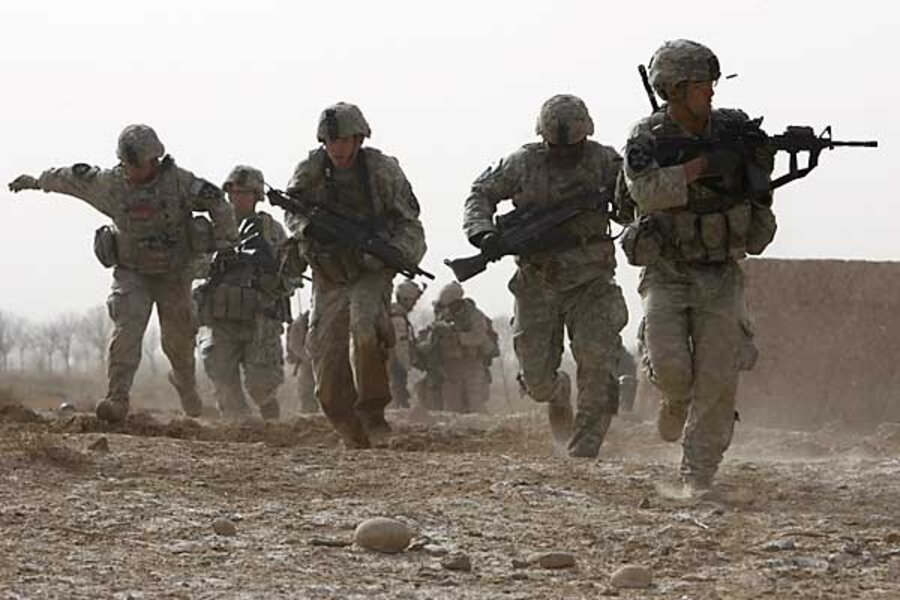Marjah offensive a test of Obama's broader Afghanistan strategy
Loading...
| Washington
The offensive in the Marjah district of Helmand Province in southern Afghanistan, which began Saturday, is a test of President Obama’s new strategy, part of a broader counterinsurgency plan that will unfold over the next several months.
Top American officials say the two-day-old operation is going well, despite a setback Sunday in which a dozen Afghan civilians appear to have been killed during a rocket strike. That is significant because current US-NATO strategy puts the protection of the civilian population ahead of killing enemy fighters.
The Marjah offensive is considered the biggest operation the US has mounted in Afghanistan since American forces arrived in October 2001. It differs from previous offensives in other ways, too: The US and allied troops are in a stronger partnership with Afghan forces than ever before, with many more Afghan soldiers and police in the fight; and the Afghan government approved the Marjah operation in recent days, unlike other operations sometimes conducted without the consent of Afghanistan President Hamid Karzai.
While in and of itself the offensive will not be a “game changer,” say American military officials, it could create the conditions to see if the new strategy, which puts nearly 100,000 Americans in Afghanistan by the end of this year, will work.
“It is the first major operation in which we will demonstrate, I think successfully, that the new elements of the strategy – which combine not only security operations but economic reform and good governance at the local and regional level with a much more visible presence of Afghan forces – will take place,” said James Jones, Mr. Obama’s national security adviser, on "Fox News Sunday."
Thousands of US marines – with Afghan soldiers or police beside them – pushed into the Marjah district over the weekend for an operation that the US military has intentionally publicized for weeks. Telegraphing the operation forced at least some of the estimated 1,000 Taliban fighters there to flee the area, and small numbers of fighters have already asked to be reintegrated into society. By announcing the operation in advance, the US hoped to "shape" the battlefield, weeding out lower-level fighters who may flee and concentrating on the more ideologically driven fighters who may stay.
“It’s very hard to make predictions about what is going to happen because it will depend heavily on how enemy leaders are going to react,” says Fred Kagan, a senior fellow at American Enterprise Institute, a conservative think tank in Washington, on Friday. “In principle, it’s shaping up to be a pretty big fight.”
The marines and the Afghan forces have met some resistance and “sporadic but intense” gunfire, according to the Los Angeles Times. The newspaper also reported that the Marine commander there, Brig. Gen. Larry Nicholson, had to duck sniper fire on Sunday. The operation is risky, too, because of the many roadside bombs that insurgents have placed in the region. The large trucks the US military uses to protect troops from such bombs won’t be as useful during this battle because it is expected to be as a street-to-street, house-to-house fight in which troops will be traveling by foot.
Gen. Stanley McChrystal, the top commander in Afghanistan, has already apologized to Mr. Karzai for the American rocket strike Sunday that killed Afghan civilians. Marines and Afghan soldiers had been taking fire from a compound in the area, but a rocket strike the Americans mounted in response that was meant to target the building hit another one instead, killing about a dozen villagers.
Some analysts and other military experts suggest that Helmand should not be the priority. Kandahar Province to the east would be a more important prize for the US-Afghan-Allied force because it is the spiritual home of the Taliban and a large population center crucial to Afghanistan's future, they argue. But most of the opium that comes from Afghanistan – which provides roughly 90 percent of the world’s production – comes from Helmand, US military officials say. About $400 million of the $4 billion the county produces is fed directly to the Taliban or to the corrupt Afghan government.
----
Follow us on Twitter.





